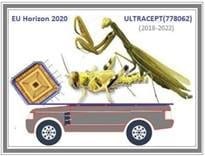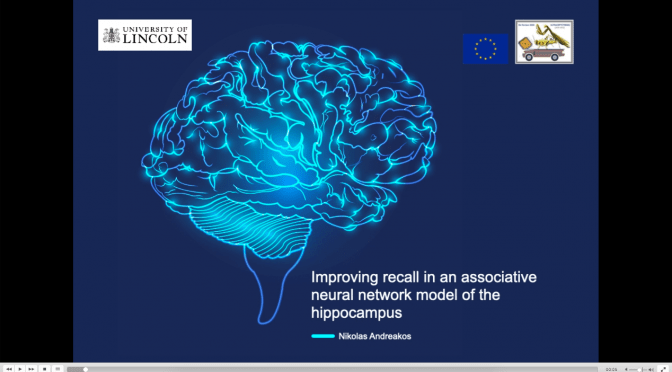Nikolas Andreakos is a PhD candidate at the University of Lincoln who is working on developing computational models of associative memory formation and recognition in the mammalian hippocampus.
Recently, Nikolas attended the 9th International Conference on Biomimetic and Biohybrid Systems, Living Machines 2020 (LM2020). This year’s conference which was scheduled to take place between 28th and 30th July 2020 in Freiburg, Germany, but due to the current situation around Covid-19, it was moved online.
Andreakos N., Yue S., Cutsuridis V. (2020) Improving Recall in an Associative Neural Network Model of the Hippocampus. In: Vouloutsi V., Mura A., Tauber F., Speck T., Prescott T.J., Verschure P.F.M.J. (eds) Biomimetic and Biohybrid Systems. Living Machines 2020. Lecture Notes in Computer Science, vol 12413. Springer, Cham. https://doi.org/10.1007/978-3-030-64313-3_1
ABOUT LIVING MACHINES 2020
The development of future real-world technologies will depend strongly on our understanding and harnessing of the principles underlying living systems and the flow of communication signals between living and artificial systems.
Biomimetics is the development of novel technologies through the distillation of principles from the study of biological systems. The investigation of biomimetic systems can serve two complementary goals. First, a suitably designed and configured biomimetic artefact can be used to test theories about the natural system of interest. Second, biomimetic technologies can provide useful, elegant and efficient solutions to unsolved challenges in science and engineering.
Biohybrid systems are formed by combining at least one biological component—an existing living system—and at least one artificial, newly-engineered component. By passing information in one or both directions, such a system forms a new hybrid bio-artificial entity. The theme of the conference also encompasses biomimetic methods for manufacture, repair and recycling inspired by natural processes such as reproduction, digestion, morphogenesis andmetamorphosis.
The following are some examples of “Living Machines” as featured at past conferences:
- Biomimetic robots and their component technologies (sensors, actuators, processors) that can intelligently interact with their environments.
- Biomimetic computers neuromimetic emulations of the physiological basis for intelligent behaviour.
- Active biomimetic materials and structures that self-organise and self-repair or show other bio-inspired functions.
- Nature inspired designs and manufacturing processes.
- Biohybrid brain-machine interfaces and neural implants.
- Artificial organs and body-parts including sensory organ-chip hybrids and intelligent prostheses.
- Organism-level biohybrids such as robot-animal or robot-human systems.
Nikolas presented his research Improving recall in an associative neural network model of the hippocampus.



Abstract
The mammalian hippocampus is involved in auto-association and hetero-association of declarative memories. We employed a bio-inspired neural model of hippocampal CA1 region to systematically evaluate its mean recall quality against different number of stored patterns, overlaps and active cells per pattern. Model consisted of excitatory (pyramidal cells) and four types of inhibitory cells: axo-axonic, basket, bistratified, and oriens lacunosum-moleculare cells. Cells were simplified compartmental models with complex ion channel dynamics. Cells’ firing was timed to a theta oscillation paced by two distinct neuronal populations exhibiting highly regular bursting activity, one tightly coupled to the trough and the other to the peak of theta. During recall excitatory input to network excitatory cells provided context and timing information for retrieval of previously stored memory patterns. Dendritic inhibition acted as a non-specific global threshold machine that removed spurious activity during recall. Simulations showed recall quality improved when the network’s memory capacity increased as the number of active cells per pattern decreased. Furthermore, increased firing rate of a presynaptic inhibitory threshold machine inhibiting a network of postsynaptic excitatory cells has a better success at removing spurious activity at the network level and improving recall quality than increased synaptic efficacy of the same threshold machine on the same network of excitatory cells, while keeping its firing rate fixed.


